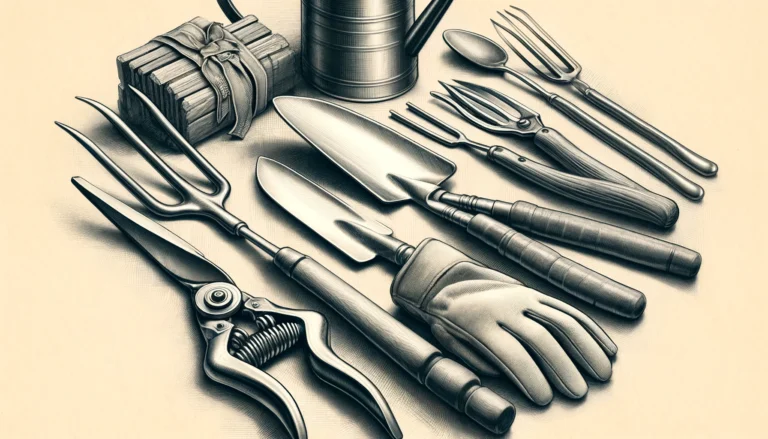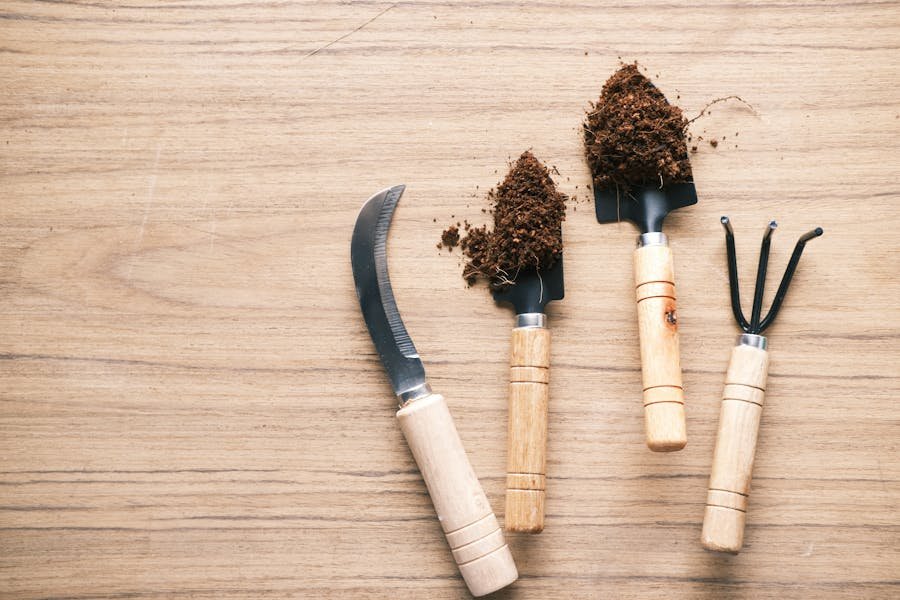Whether you’re a seasoned gardener or just starting out, having and learning the right garden tools names for planting is neccessary for both the ease and success of your gardening projects.
This guide will walk you through all essential garden tools names you need to learn for various planting tasks.
From basic hand tools to more advanced equipment, helping you make informed choices that suit your gardening style and needs.
Proper tools not only make the task of planting more enjoyable but also ensure the health and prosperity of your plants.
In this article, we’ll explore different types of garden tool names essential for planting, what features to look for, and tips on how to use them effectively.
By the end of this post, you’ll be well-equipped to handle any gardening challenge that comes your way!
Table of Contents
- Understanding Different Types of Garden Tools Names for Planting
- Choosing the Right Garden Tools for Different Plants
- Essential Features to Look for in Garden Tools
- Innovative Garden Tool Names for Efficient Planting
- Tips and Tricks for Using Garden Tools Effectively
- FAQ - Garden Tools Names for Planting
- Conclusion
Understanding Different Types of Garden Tools Names for Planting
Basic Hand Tools Names for Planting
- Trowels: A trowel is a gardener’s best friend. Its primary use is for digging small holes, transplanting seedlings, and mixing soil additives. Trowels come in various shapes and sizes, with a pointed, scoop-shaped metal blade that can easily penetrate the soil.
- Hand Rakes: Essential for smoothing soil and clearing debris, hand rakes are invaluable in preparing your garden bed. They are particularly useful for breaking up clumps of soil and ensuring an even surface for planting.
- Weeding Forks: These small forks are perfect for removing weeds by their roots, ensuring they don’t grow back quickly. A weeding fork should be durable and have sharp tines for easy insertion into the soil around plants, minimizing disturbance to their roots.
Advanced Planting Equipment
- Bulb Planters: These tools are specifically designed for planting bulbs and are especially handy in the fall when preparing for spring blooms. Bulb planters help gardeners plant bulbs at the correct depth with minimal effort. They typically come with a depth gauge, which helps ensure that each bulb is planted deep enough to provide protection during winter but close enough to the surface to sprout in spring.
- Garden Forks and Spades: These are used for turning over soil, especially in new beds or where the soil is particularly compact. A garden fork is great for aerating soil without disturbing the underlying structure, while spades are ideal for cutting into tough soil and sod.
- Seed Spreaders: For those with larger gardens or who like to work efficiently, a seed spreader is a must. It allows for even distribution of seeds, which is crucial for uniform growth. They range from simple hand-held models for small areas to larger push-along devices for big plots.
Choosing the Right Garden Tools for Different Plants
Selecting and learning the appropriate garden tools names for planting based on the types of plants you intend to grow can make a significant difference in both the ease of gardening and the health of your plants.
Here’s a breakdown of what tools work best for different planting scenarios:
Tools for Flower Planting
Precision and care are key when planting flowers, especially delicate varieties:
- Hand trowels with narrow blades are perfect for planting bulbs and transplanting small flowers without disturbing neighboring plants.
- Watering cans with long spouts offer the ability to water newly planted flowers gently and accurately, reducing soil displacement.
- Pruners are essential for trimming and shaping plants to encourage healthy growth.
Vegetable Garden Tools
Vegetable gardens require robust tools that can handle larger, tougher jobs:
- Hoes and cultivators are crucial for weed control and preparing planting rows in your vegetable garden.
- Garden forks are invaluable for turning the soil and mixing in compost or fertilizer, promoting healthy root growth.
- Wheelbarrows help in transporting soil amendments, compost, or harvests across larger vegetable patches.
Tools for Tree and Shrub Planting
Planting trees and shrubs involves much heavier work, and thus, more substantial tools are needed:
- Shovels with a wide, flat blade are ideal for digging bigger holes required for trees and shrubs.
- Loppers and saws are necessary for pruning larger branches to shape the plants or remove dead or diseased limbs.
- Stakes and ties may be required for supporting young trees until their root systems are fully developed.
Matching Tools to Plant Needs
Each type of plant in your garden has unique needs regarding soil preparation, planting depth, and ongoing care.
Therefor, we need to choose tools that not only make the job easier but also help ensure the health and productivity of our plants.
For instance, using a heavy shovel for delicate flower planting could damage the plant roots, while a small hand tool would be impractical for large-scale vegetable gardening.

Essential Features to Look for in Garden Tools
When investing in garden tools for planting, it’s essential to consider certain features that can enhance their functionality, durability, and ease of use.
Here’s what to look for:
Material and Durability
Stainless Steel vs. Carbon Steel:
- Stainless Steel: Ideal for its rust-resistance and overall durability. Stainless steel tools are slightly more expensive but are a good investment for those looking for longevity.
- Carbon Steel: Known for its strength and sharpness, carbon steel is great for tools like pruners and trowels but requires more maintenance to prevent rust.
Ergonomics and Comfort
Reducing Physical Strain:
- Look for tools with ergonomic handles that are designed to reduce stress on your hands and wrists. Tools with padded or specially shaped handles can greatly increase comfort, particularly during long gardening sessions.
- Lightweight tools are also advantageous, as they reduce the overall strain on your arms and back, making gardening more accessible.
Considerations for Specific Tools
- Trowels and Spades: Opt for models with a full tang (where the metal part extends into the handle), which provides extra strength and durability.
- Rakes and Hoes: Ensure that the connection between the handle and head is secure and robust to withstand repetitive motion and pressure.
- Pruners: Choose models with replaceable blades and tension adjustment features, allowing for personalized tool maintenance and use.
Innovative Garden Tool Names for Efficient Planting
As technology advances, so do garden tools, making planting and maintaining gardens more efficient and less labor-intensive. Here are some innovative tools that incorporate modern technology or sustainable practices:
Smart Garden Tools Names
Sensor-Equipped Tools:
- Moisture sensors in tools can help gardeners determine when plants need water, preventing over or under-watering.
- pH meters integrated into tools allow for quick soil tests, enabling gardeners to adjust soil conditions perfectly suited for different types of plants.
Automated Planting Assistants:
- Devices that help space seeds accurately or suggest optimal planting depths can take the guesswork out of planting, which is particularly useful for novice gardeners.
Eco-Friendly Tools
Sustainability in the Garden:
- Recycled Materials: Many companies now offer tools made from recycled or sustainable materials, reducing the environmental impact of their products.
- Biodegradable Pots: For starting seeds, biodegradable pots made from coconut coir or peat can be planted directly into the soil, reducing transplant shock and waste.
Innovative Design Features
Enhanced Functionality:
- Multi-tools: Some garden tools have been designed to serve multiple purposes, such as a combination of trowel, weeder, and soil scooper. This reduces the need for multiple separate tools and the resources used to make them.
- Extendable Handles: Tools with adjustable handles can be lengthened or shortened to suit the task and user, which enhances comfort and reach without the need for bending or stretching excessively.
The Impact of Technology on Gardening
Technology not only makes gardening more accessible but also more precise.
Overall, precision can lead to better plant growth, higher yields, and more efficient use of resources like water and fertilizer.
By embracing these innovations, we can enjoy more productive gardens with less physical strain.
Tips and Tricks for Using Garden Tools Effectively
To get the most out of your garden tools and ensure your gardening efforts are as productive as possible, here are some practical tips and common mistakes to avoid:
Techniques for Efficient Planting
Optimal Use of Tools:
- Use a trowel to dig to the exact depth required for the seeds or plants, which is often listed on the seed packet or plant tag. The right depth ensures proper root development and plant stability.
- When digging larger holes for trees or shrubs, use a spade to slice through the soil cleanly. This makes it easier to remove the soil and creates a smooth-walled hole that helps roots penetrate the surrounding soil.
- After sowing seeds, use a rake to gently cover the seeds with soil, which should be just thick enough to shield them from sunlight but not so thick that they cannot sprout.
Common Mistakes to Avoid
Gardening Blunders:
- Overusing the Tools
- Improper Tool Maintenance
- Using Dull Tools
Don’t use a single tool for multiple inappropriate tasks (like using a trowel to pry open a container), which can damage the tool and make the task harder than necessary.
Failing to clean and store your tools properly can lead to rust and deterioration, shortening their lifespan significantly.
Working with dull blades on pruners or spades makes gardening more labor-intensive and can harm plants, making clean cuts necessary for healthy plant growth.
FAQ - Garden Tools Names for Planting
- Trowel: Essential for digging, transferring plants, and mixing soil.
- Spade: Ideal for bigger jobs like digging holes for trees and turning soil.
- Pruning Shears: Necessary for trimming and shaping plants.
- Garden Fork: Great for loosening and aerating soil.
- Watering Can: Crucial for gentle watering, especially for new plantings and seedlings.
Garden tools don’t have a set expiration date, but their lifespan depends on the quality of the tool and how well they are maintained. Regular cleaning, proper storage, and sharpening can extend the life of a tool significantly.
Many tools used for outdoor planting can be used indoors, but it’s often beneficial to have smaller, more precise tools for houseplants. Miniature trowels, pruners, and rakes are more suitable for the confined spaces of pots and planters.
- Consider the physical fit: tools should feel comfortable in your hands and not cause strain during use. Also, the size of your garden should influence the size of your tools; larger gardens might require more robust tools.
- For those with physical limitations or smaller frames, lightweight and ergonomically designed tools can make gardening more enjoyable and less strenuous.
Conclusion
In this comprehensive guide, we’ve explored the essential garden tools names for planting, highlighting the importance of choosing the right tools.
By investing in quality garden tools and maintaining them properly, you can ensure a more productive and enjoyable gardening experience.
Overall, gardening is not just about the physical tools but also about the knowledge and techniques you apply.
Whether you are planting delicate flowers, robust vegetables, or majestic trees, the right tools will make your work easier, more effective, and more rewarding.
Now you should have a robust understanding of all the basic garden tools names for planting.
As a result, you can begin or move forward along your gardening journey with confidence!

